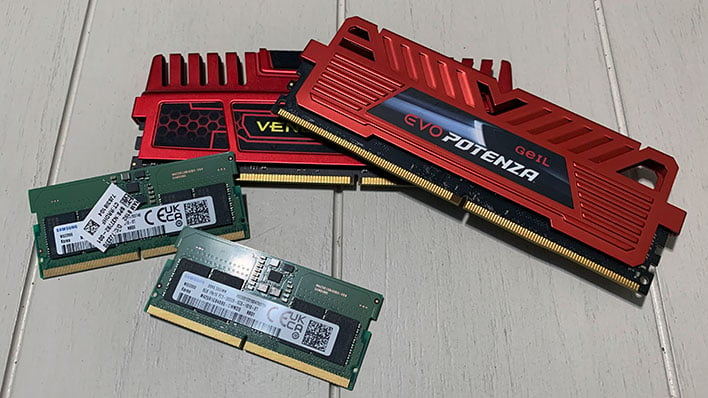Memory Chip Makers Still Plan To Hike DRAM Prices After DDR5 And DDR4 Buying Spree

The threat of rising PC memory prices has been looming for several months now and, despite a recent surge in supply-side revenue, is still something to be on the lookout for as we head into 2024. That's according to TrendForce and its recent investigations into the state of DRAM, which found a "significant leap in the DRAM industry" for the third quarter of this year.
According to TrendForce, DRAM revenues soared to $13.48 billion during the quarter, marking an impressive 18% quarterly spike. The market research firm attributed the revenue gain to a "gradual resurgence in demand," which prompted clients to scoop up more memory chips.
That's great and wonderful for chip makers who have been sweating sales due to an oversupply of DRAM chips, but what does it mean for consumers at retail? That remains to be seen, though TrendForce did make clear that suppliers are still "firmly set on price hikes, with DRAM contract prices expected to rise by approximately 13-18%."
In other words, the tailwind from sales in the third quarter of this year is apparently not enough for memory chip makers to adjust their course as they head into the new year. And the way chip makers can control pricing is by reducing wafer outputs. That plan is still very much on the map, at least for the near future.
"Samsung expanded its production cuts by the end of Q3, mainly targeting DDR4 products with high inventory levels. The cutback is expected to intensify to 30% in Q4, reducing overall wafer inputs," TrendForce states.
There's reason not to panic, though. For one, the production cuts will supposedly be temporary—according to TrendForce, Samsung and SK hynix are both planning to ramp up wafer production starting in the second quarter of next year, as a recovery in demand is expected for the second half of next year.
Secondly, we've seen memory prices plummet over the past few years. Even DDR5, which came out of the gate with obscene premiums (compared to DDR4), has settled down. Here are some examples of retail kits that are currently available...

- 32GB TeamGroup T-Create Classic DDR5-6000: $85.99
- 32GB G.Skill Trident Z5 RGB DDR5-6000: $112.99
- 32GB Corsair Vengeance DDR5-5200: $89.99
- 32GB TeamGroup T-Force Delta RGB DDR4-3600: $75.99
- 32GB G.Skill Trident Z RGB DDR4-4000: $89.99
Looking at the DDR5 kits, those prices are much lower than they were a relatively short while ago. For example, the 32GB Corsair Vengeance DDR5-5200 memory kit debuted at $359.99. The current price of $89.99 represents a 75% drop.
That's not all supply related, of course—there's often a so-called early adopter tax on new and emerging technology, and we saw that play out with DDR5. Pricing on DDR5 kits at 6000MT/s and 5200MT/s is generally not much higher than DDR4-3600 pricing (though it depends on the specific kit, as prices vary wildly).
DDR4 pricing has continued to come down as well. Looking at that 32GB G.Skill Trident Z RGB DDR4-4000 memory kit, it was selling for $164.99 as recently as April of this year, and has since fallen by more than 45%.
On the high end of TrendForce's prediction, a price hike of 18% that gets fully pushed to consumers would mean a kit that costs $85.99 will shoot up to $101.47, to give you an idea of where things could be headed.
Supply side costs don't always translate so neatly to retail, though, so we'll have to sit back and see how it plays out. In the meantime, our recommendation is the same as it has been for several months now—if you spot a good deal on RAM and are in need of an upgrade, the smart gamble is to pull the trigger rather than hoping for another price cut.

